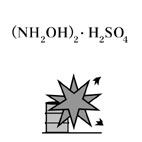| Case Name |
Explosion at a reactor caused due to a temperature rise of a recovery process of hydroxylamine sulfate at a pharmaceutical production plant |
| Pictograph |

|
| Date |
September 6, 1974 |
| Place |
Amagasaki, Hyogo, Japan |
| Location |
Pharmaceutical factory |
| Overview |
In 1974, an explosion occurred at a recovery process of hydroxylamine sulfate from a waste liquid in a pharmaceutical manufacturing plant in Amagasaki, Hyogo. The upper half of the reactor blew off and the ceiling of the building ruptured. |
| Incident |
An explosion occurred from an exothermic reaction in a recovery process for waste from a pharmaceutical manufacturing plant. The waste was including mainly methyl isobutyl ketoxime (MIBK oxime), which is obtained from a reaction of adding MIBK to a mixture of hydroxylamine sulfate and a trace of carboxylic acid. |
| Processing |
Manufacture |
| Individual Process |
Concentration |
| Process Flow |
Fig2.Unit process flow 1
|
| Chemical Equation |
Fig3.Chemical reaction formula
|
| Substance |
Hydroxylamine sulfate, Fig4 |
| Sulfuric acid, Fig5 |
| Methyl isobutyl ketoxime, Fig6 |
| Type of Accident |
Explosion |
| Sequence |
To recover hydroxylamine sulfate from a waste liquid of a pharmaceutical plant, the waste liquid and dilute sulfuric acid were poured into a reactor and cooled overnight. Next morning, the mixture was concentrated at 70 °C under reduced pressure, and left for 30 minutes at reduced pressure after heating was stopped. The material was jelly-like, so heating was started again. Suddenly, a whistling sound was heard coming from inside, so cooling water was hurriedly fed into the jacket of the reactor, but the material in the reactor exploded. The upper half of the reactor blew off and the ceiling of the building ruptured. |
| Cause |
The waste was hydrolyzed with dilute sulfuric acid to MIBK and hydroxylamine sulfate. During concentration under reduced pressure, MIBK oxime in the hydrolysate was assumed to stick to the inner wall of the reactor. By heating after concentration, the temperature of the headspace reached 100 °C, an exothermic reaction resulted in Beckman rearrangement of oxime, and hydroxylamine sulfate was ignited by the high temperature caused by Beckman rearrangement. |
| Countermeasures |
The temperature should be kept under 100 °C. A temperature alarm should be mounted at the reactor. If possible, the possibility of the contents sticking to the inner wall of the reactor should be reduced. |
| Knowledge Comment |
1. Keeping the temperature lower than the hazardous level of a specific chemical process.
2. The temperature of the inner wall of a reactor can be higher if it is not covered with a liquid. Paying attention not to leave products sticking to the inner wall is important. |
| Background |
The cause of the accident is considered that operators did not know that Beckman rearrangement takes place above 100 °C, or the operation manual failed to pay attention to Beckman rearrangement. |
| Reason for Adding to DB |
Example of explosion caused due to temperature raising to a hazardous range |
| Scenario |
| Primary Scenario
|
Ignorance, Insufficient Knowledge, Insufficient Study of Reation, Poor Value Perception, Poor Safety Awareness, Insufficient Education/Training, Hydrolysis, Planning and Design, Poor Planning, Unclear Operating Indication, Regular Movement, Careless Movement, Interruption at Halfway, Bad Event, Chemical Phenomenon, Heat Generation/Ignition, Secondary Damage, External Damage, Explosion, Bodily Harm, Injury, Loss to Organization, Economic Loss
|
|
| Sources |
Masamitsu Tamura. Masahide Wakakura. Hydroxylamine sulfate explosion. Reaction danger. - Accident cases and analysis - p161(1995)
|
| Number of Injuries |
1 |
| Multimedia Files |
Fig4.Chemical formula
|
|
Fig5.Chemical formula
|
|
Fig6.Chemical formula
|
| Field |
Chemicals and Plants
|
| Author |
YOSHINAGA, Jun (Graduate School of New Frontier Sciences, The University of Tokyo)
TAMURA, Masamitsu (Center for Risk Management and Safety Sciences, Yokohama National University)
|
|